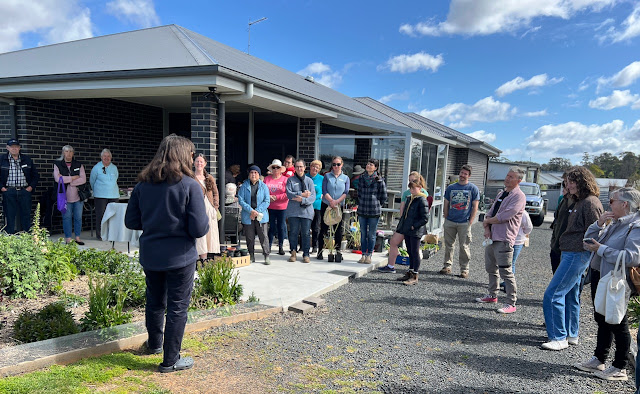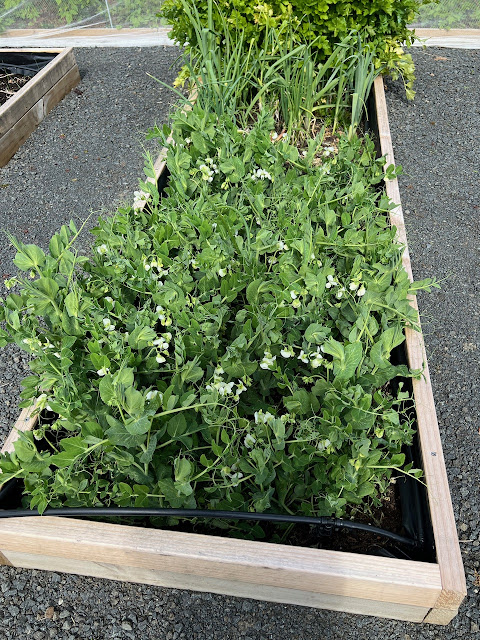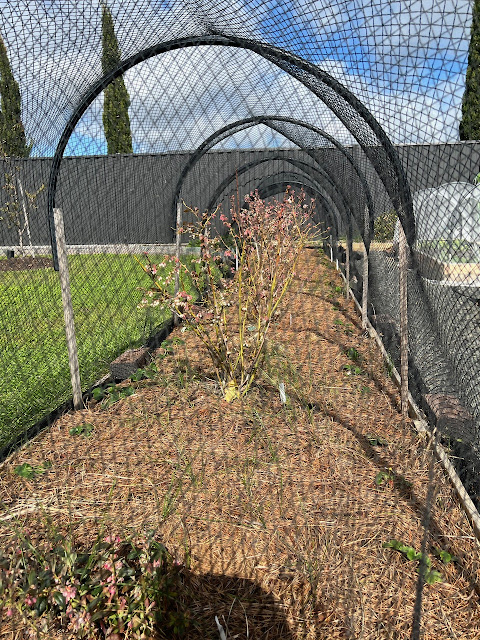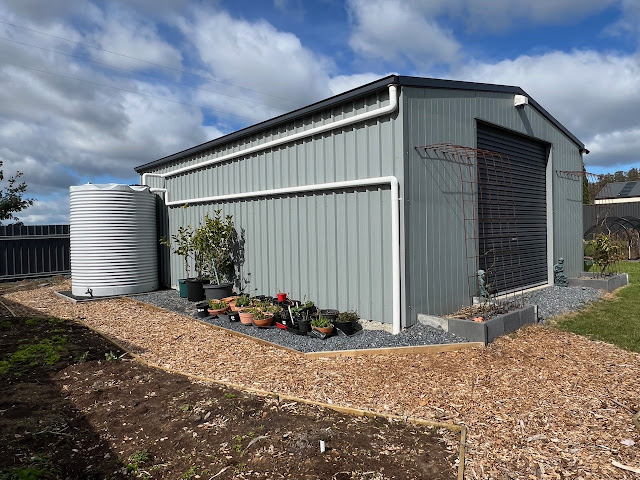The first ever Northern Food Garden Group visit was a major success with 30 enthusiastic people turning up with great contributions to the produce and morning tea tables. There was some sun, not too much wind, and even some Northern warmth in the air, as we looked around host Denby's great garden. After sharing our food growing experiences, many good chats, and a great morning tea, everyone left with a smile on their face and produce, seeds or plants in their hands. This was a brilliant start to what promises to become a vibrant Northern group. Read all about it below.
Denby (in the foreground with the navy-blue jacket) bought this property in June 2023. At that stage the large back garden was virtually empty except for a shed, grass, and a few bushes. So the young productive food garden we saw during this visit is the result of some very hard work over only a bit more than a year. It showed everyone what can be achieved if you are focused and know what you want to achieve.
Denby explained that planning the layout was quite daunting, but she feels that things have worked out.
Next to her house she created an ornamental area that attracts many bees.
Every garden has its pros and cons. Denby's garden is large and gets plenty of sun, but it is on top of a hill and therefore subject to strong winds. Also, the soil that was there is solid clay.
She got three truck loads of food garden soil. Each load came from a different company. The best soil of the three was called Veggie Mix and it came from Glebe Gardens. Denby is finding that her plants are really happy with that.
Most of the grass was stripped back. She didn't use glyphosate to kill remaining weeds, but used cardboard to cover it where there was still some left after that. It has done the trick!
Twelve 90 centimetre-wide low raised beds were created. Paths were filled with pebbles, but not before irrigation pipes that go to every raised bed were put in the ground, so they won't be a trip hazard.
Denby was not afraid to ask for help and employ trades people where a job that was beyond her capacity needed to be done. That proved to be a good strategy!
 |
| A healthy crop of garlic on the way |
The soil that she brought in has now somewhat subsided, and she is finding that she needs to add more, so some beds already have a second frame around them to make them higher, and I predict that a third layer of bordering timber will arrive sooner or later, but then her custom-made raised beds will hold a lot of very good soil.
Every bed is fitted with irrigation pipe. Denby will attach sprayers to them later in the season when irrigation is needed.
The photo below shows a healthy crop of Greenfeast peas. Denby allows them to grow without a trellis. I have seen North-West farmers with acres of peas, all on the ground, that are very productive without any supports. Most home gardeners, however, grow their peas on trellises. Denby sowed her pea seeds in late autumn, and they grew through periods of frost, without complaining.
A long blueberry bed forms the border of the veggie garden, on the right, and the orchard on the left. Here Denby has many varieties of blueberries that were all flowering profusely.
In her orchard she planted apricot, cherry, apple, nectarine and peach trees on mounds, because of the underlying clay soil. All are fitted with a piece of perforated drainage pipe for watering in summer.
Here we also found four berry patches filled with raspberries, strawberries and a thornless blackberry and youngberry.
It will be great to see this garden again in a few years time when everything will have grown up a lot.
It is inevitable that some plants will fail, but if you don't give up, you gradually become an expert in what works in your local environment, and your garden will thrive.
Here is an example: Denby planted a lime and lemon tree in the garden that had been growing in pots for many years, only to have them badly affected by multiple heavy frosts. We discussed this with the group. Others, more experienced with frosts, recommended that she puts a simple frame over each citrus fruit, and covers these frames with shade cloth or any other cloth when the forecast is for a frosty night. You don't leave those covers over the trees during the day. You remove them again the next morning. It is recommended that you use frames, so you don't have the cloth straight on the branches.
A passion fruit against the shed caught my attention because of its clever frame.
Denby explained that the bush looked so battered because of the strong winds that come straight towards it. It might be better to move this bush to one of the other sides of the shed.
Denby showed me a nicely organised set of garden tools in her shed. Much better than my messy setup.
Next to the shed is a large water tank that very nicely collects all the rain water from the large roof.
Most of us rely on tap water to water our plants in summer, but rain water, without the chloride, is much better for plants.
Not far from the shed is a utility area where I found three Tumbleweed 400 Litre composters.
I liked the creative use of large concrete blocks for sweet peas in the fence that borders this area.
Thanks everyone for all the yummy and wonderful things that you brought .....
For host Denby this day was a double challenge, because this was the first ever food garden event she had organised (with help from someone who has done this before) and she was also showing her food garden to other food gardeners.
Well, if there was any nervousness, there is no need for that after today. We saw a great garden during a well-organised very successful visit! A few people put their hand up for a future visit to their garden AND someone put their hand up for writing up future food garden visits (thank you Nicki).
Well done, Northern coordinator Denby, you're on a roll!















No comments:
Post a Comment
Note: Only a member of this blog may post a comment.